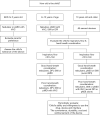A path to successful patient outcomes through aerosol drug delivery to children: a narrative review
- PMID: 33987291
- PMCID: PMC8105845
- DOI: 10.21037/atm-20-1682
A path to successful patient outcomes through aerosol drug delivery to children: a narrative review
Abstract
Although using aerosolized medications is a mainstay of treatment in children with asthma and other respiratory diseases, there are many issues in terms of device and interface selection, delivery technique and dosing, as well as patient and parental education that have not changed for half a century. Also, due to many aerosol devices and interfaces available on the market and the broad range of patient characteristics and requirements, providing effective aerosol therapy to children becomes a challenge. While aerosol delivery devices are equally effective, if they are age-appropriate and used correctly, the majority of aerosol devices require multiple steps to be used efficiently. Unfortunately, many children with pulmonary diseases have problems with the correct delivery technique and do not gain therapeutic benefits from therapy that result in poor disease management and increased healthcare costs. Therefore, the purpose of this paper is to review the current knowledge on aerosol delivery devices used in children and guide clinicians on the optimum device- and interface-selection, delivery technique, and dosing in this patient population. Strategies on how to deliver aerosolized medications in crying and distressed children and how to educate parents on aerosol therapy and promote patient adherence to prescribed medications are also provided. Future directions of aerosol therapy in children should focus on these issues and implement policies and clinical practices that highlight the potential solutions to these problems.
Keywords: Aerosols; and children; facemask; high flow nasal cannula; inhalers; nebulizers.
2021 Annals of Translational Medicine. All rights reserved.
Conflict of interest statement
Conflicts of Interest: The author has completed the ICMJE uniform disclosure form (available at http://dx.doi.org/10.21037/atm-20-1682). The series “Medical Aerosol in Acute and Critical Care” was commissioned by the editorial office without any funding or sponsorship. AA reports personal fees from Bayer Pharmaceuticals, personal fees from Sunovion Pharmaceuticals, grants and personal fees from Aerogen Ltd., Grants from ARC Medical, outside the submitted work. The author has no other conflicts of interest to declare.
Figures




References
Publication types
LinkOut - more resources
Full Text Sources
Other Literature Sources
Medical
